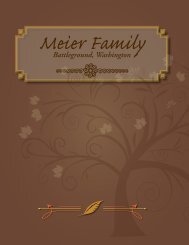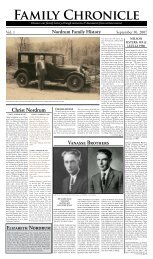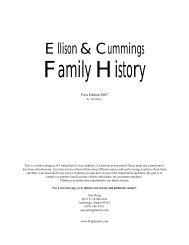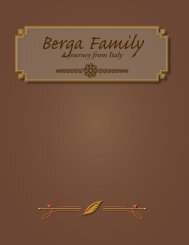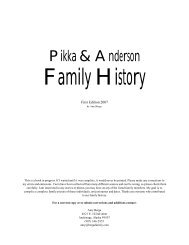Meier & Matson Family History
Meier & Matson Family History
Meier & Matson Family History
You also want an ePaper? Increase the reach of your titles
YUMPU automatically turns print PDFs into web optimized ePapers that Google loves.
<strong>Meier</strong> <strong>Family</strong> <strong>History</strong><br />
Babies were baptized, marriages preformed and sacraments distributed. On this day, the parish was founded. From this<br />
day forward, Father Pierz came to conduct services in the homes of Frank Weber, Peter Lorsung and the Miller’s home.<br />
(Source: Our Founder’s Legacy)<br />
One outdoor afternoon in late summer of 1866, settlers were enjoying a religious service on the spacious prairie of<br />
Constant Cichy and his wife Katherine. All had come by wagon and foot with food in hand enough for two days. In this<br />
general meeting ideas and plans for a township were exchanged freely. Plans were made to organize their town, naming<br />
it Millerville after the John A. Miller who was the leader of the German settlers from Philadelphia, Pennsylvania,<br />
immediately after the end of the Civil War. The first recorded meeting was held on April 17, 1878. (Source: Our<br />
Founder’s Legacy)<br />
“Eighteen months had elapsed since John A. Miller and John Lorsung came to the area which was now officially named<br />
Millerville. In the spring of 1868, one year after Father Pierz had founded the Parrish, all plans were made to build a log<br />
church. The timbers were taken from the land of John Hockert, an unmarried man. Sawed boards, nails, shingles and<br />
windows came from St. Cloud, by oxen team. August 14, 1868 their church was finished. The altar was a table built of<br />
the remnant boards, as well as laid out for the flooring. There was no money for pews, so boards supported by wood<br />
blocks served as pews. The faithful knelt on splintery boards giving thanks. The building of the church was a community<br />
event, any giving up of their valuable time of clearing land for their crops and gave instead to the labor and construction.<br />
On August 15 1868, with great pride, the community celebrated with Father Pierz in their completed building. Both the<br />
mother of Johann Lorsung, and John A. Miller donated each 20 acres to the church. This was intended to assist in the<br />
support of the church. The church was given the impressive name of Prairie De St. Marie O’ Chippewa by Father Pierz.<br />
In 1880 a belfry was added. This same bell is still calling parishioners to worship.” (Helen Joos Cichy)<br />
“Father Pierz was accustomed to a harsh life in Minnesota wilderness and mother surprised him. He obviously had a<br />
keen sense of humor when his best intentions backfired. Whether a home had a floor or not, all had a pit beneath where<br />
root vegetables and turnips were stored, and covered by a board. This space was covered with a trap door of hewn logs or<br />
boards. A heavy table set upon this door. With all these fine preparations it was considered a good home for Father Pierz<br />
to stop and offer the Mass for the parishioners. As usual, Father Pierz spoke to a packed house. As he turned to give the<br />
final blessing, the door upon which he was standing collapsed, and down went Father Pierz into the dark pit below,<br />
landing him on potatoes, rutabagas and cabbages. While the women wring their hands in anguish, the children cried and<br />
the men proceeded to rescue him from this predicament. After it was found that the Missionary was none the worse for<br />
his undignified experience, he apologized for having caused the owners so much damage to their home. Whereupon he<br />
blessed them all again and broke for lunch. The damage was soon repaired and the table set for the usual pot luck lunch<br />
provided by the ladies. All were hungry as many had walked many miles, and would walk many more miles for their<br />
return home.” (Source: Our Founder’s Legacy)<br />
“The harness maker was an important as the oxen in the development of any community. In 1873, Peter B. Lorsung, the<br />
son of Joseph P. Lorsung and Mary Debilzan Lorsung, opened his harness making business in an existing shop. It was a<br />
two story building, providing living accommodations above the store front below. Peter B. Lorsung purchased a business<br />
building from the Kotchevar family, adding a line of shoes for all the families needs along with the harness shop. Peter B.<br />
Lorsung married Mathilda Wedl of Elizabeth, Minnesota. He was fortunate to have the post office located in his new<br />
building which had been in the Kotchevar store for many ears. Peter B., as he was known by all, became the postmaster<br />
and held that position until the post was lost in 1907. Peter with William Glebe, manufactured cement blocks in a small<br />
frame building on Lorsung’s lot. With these blocks he constructed a comfortable home for their family, as well as<br />
provided the cement blocks to build the new public school. Peter B. Lorsung conducted his extensive business, held<br />
public offices, served on the school board and served his community well until his death in June 17, 1916.” (Source: Our<br />
20



